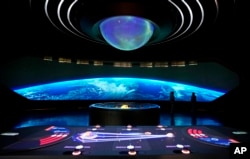Dubai has opened the dreamlike world of its new Museum of the Future.
The torus-shaped, rounded structure rises almost 70 meters. It is held up by an unusual network of supports. Light flows in through the many windows around the building. The windows are shaped in beautiful forms of Arabic letters.
The Museum of the Future represents Dubai’s continuing desire to be seen as a modern city of the United Arab Emirates. Its political system, however, remains rooted in ancestral rule. Freedom of expression is limited in the emirate.
The museum presents an idea of what the world could look like 50 years from now. The imagined future crystalizes the UAE’s 50 years of development from a small, sea-based community to a center of oil and gas riches.
“It was an imperative requirement to develop so fast because we needed to catch up with the rest of the world,” said Sarah Al-Amiri. She is the UAE’s minister of state for high technology. She also is the chair of the UAE Space Agency. She added that, before 1971, there were “no basic road networks, no basic education, electricity network and so on.”
The UAE announced last year that it would join other nations in cutting the release of heat-trapping gasses and reducing fossil fuel use in the country. Fossil fuels include oil, coal and natural gas.
The museum deals with the idea of a sustainable future. It invites visitors to reconnect with their senses and disconnect from their phones. However, digital screens and similar media also play a big part in many areas. The museum’s digital screens urge visitors to think about the planet’s health and biological mix in a city that celebrates riches, high-cost living and material goods.
Al-Amiri said the museum organizers hope to show that progress toward a sustainable future and healthy planet should not bar economic growth.
Creative director Brendan McGetrick agrees. Dealing with climate change “doesn’t mean that you have to return to … some hunter gatherer lifestyle,” he said. People can still invent and build and grow technologically, he said. McGetrick added, “…It should be done with an awareness of our relationship to the planet and that we have a lot of work to do.”
The museum’s goal is to get people to think about what is possible and to turn that into real world action, he said.
Visitors to the Museum of the Future hear about a future of flying taxis, windfarms and a world powered from space. Some projects would capture the sun’s energy and send it to the moon. The so-called “Sol Project” would cover the moon with solar collectors that would direct energy toward devices on Earth.
As the museum presents it, humans will be healthy and happy in the future. And, life on the future planet includes a new plant that is resistant to fire.
McGetrick said the museum wanted to create a powerful picture “of what would happen if we imagine space as a shared resource.”
The museum shows a future in which humanity’s collective energy project is directed by a space station called the OSS Hope. It is the same name the UAE gave its real space mission to the atmosphere of Mars. Last year, the UAE became the first Arab country to send a spacecraft to another planet.
The museum’s imagined future also is influenced by Islam’s past. For example, one area displays the planets in our solar system mapped using scientific tools called astrolabes. Muslims developed these complex devices hundreds of years ago.
The museum’s Arab influence includes a meditation space that is part of a larger sensory experience guided by vibration, light and water. These three elements were important to life for tribes in the Arabian Peninsula.
The oil-fueled cities of the Gulf that have grown in the recent past continue to change how people in the area live, interact and connect with nature.
“It’s always important to continue to evolve and develop and understand what parts of the culture actually push development forward,” said Al-Amiri. “Creating new norms and new ways of living and new ways of coexisting is OK.”
The centerpiece of the museum is a darkened mirrored space lit by tall columns of small glass shapes. The shapes hold the imaginary DNA of animals and plants that disappeared from existence, the polar bear among them.
In this idea of the future, the health of the planet is observed much like a person’s heartbeat and temperature are.
Entrance to the Museum of the Future costs about $40 for an adult.
Dubai ruler Sheikh Mohammed bin Rashid Al Maktoum was present at the official launch of the museum. It is his poetry that covers the building in Arabic lettering.
The building’s designers, UAE-based Killa Design, said the building has been awarded LEED Platinum status. The rating is given to building designs that use energy as efficiently as possible and meet other environmental goals.
I’m Caty Weaver.
The Associated Press reported this story. Caty Weaver adapted it for VOA Learning English.
____________________________________________________________________
Words in This Story
torus-shaped –n. a rounded circular shape
crystallize –v. to cause something such as an idea or belief to become fully formed
imperative –adj. very important
sustainable –adj. involving methods that do not completely use up or destroy natural resources
digital screen
meditation –n. the act or process of spending time in quiet thought; the act or process of meditating
vibration – n. continuous slight shaking movement; a series of small, fast movements back and forth or from side to side
evolve –v. to change or develop slowly often into a better, more complex, or more advanced state
norm –n. a normal way of doing something
column –n. a long post made of steel, stone, etc., that is used as a support in a building



